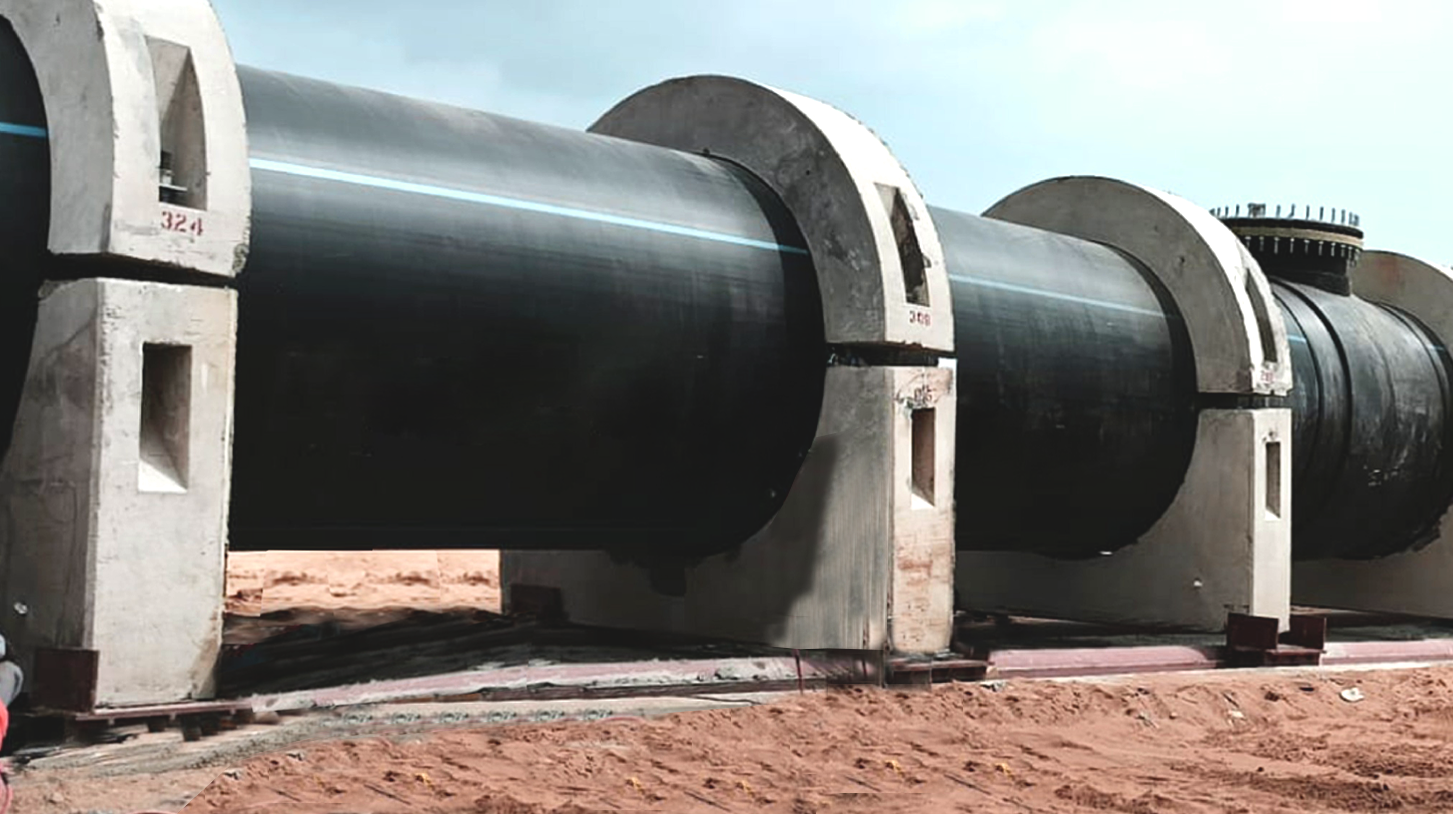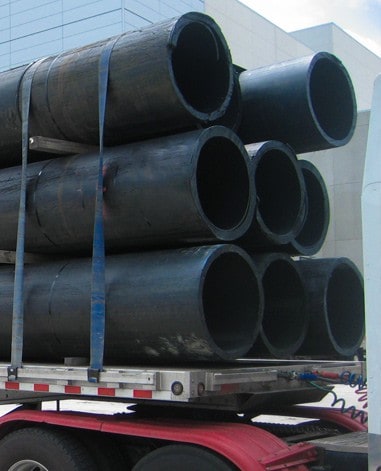American Plastics HDPE Pipe for Oilfield: Strength in Harsh Environments
Wiki Article
Discover the Manufacturing Refine Behind High-Quality HDPE Pipe and Its Applications
The manufacturing process of top notch HDPE pipes is intricate and systematic. It begins with the choice of basic materials that improve efficiency. Following this, ethylene goes through polymerization to create material, which is after that formed via extrusion. Quality control is extremely important, guaranteeing that the final product fulfills rigorous criteria. Nonetheless, the trip of HDPE pipes doesn't finish with manufacturing. Their applications throughout various markets expose a wider significance worth checking out.Comprehending HDPE: Residences and Advantages

High-density polyethylene (HDPE) is a versatile polycarbonate known for its toughness and resistance to numerous environmental elements. This product exhibits excellent tensile toughness, making it ideal for demanding applications. Its low-density framework contributes to a lightweight item, helping with ease of handling and installation. HDPE likewise showcases amazing resistance to chemicals, which decreases destruction when revealed to extreme substances.
The material's low dampness absorption further enhances its longevity, making it perfect for usage in pipes and storage space tanks. Additionally, HDPE is resistant to ultraviolet (UV) radiation, guaranteeing that products preserve their stability even when exposed to sunlight. Its adaptability permits for the creation of complex forms without compromising toughness. The eco-friendly nature of HDPE, typically originated from recycled products, contributes to its allure, advertising lasting practices in production. In general, these residential properties and benefits make HDPE a preferred selection for different industrial and consumer applications.
Basic Material Option for HDPE Production
The choice of raw products for HDPE production is essential to verify the last item fulfills the preferred specifications and quality requirements. High-density polyethylene (HDPE) is largely generated from polymerized ethylene, stemmed from nonrenewable fuel sources such as natural gas or petroleum. The top quality of these feedstocks considerably affects the mechanical and thermal residential properties of the last HDPE.Additives likewise play a considerable function in boosting HDPE's efficiency, including anti-oxidants, UV stabilizers, and colorants, which enhance sturdiness and resistance to ecological variables. The option process need to consider not only the chemical make-up of the raw materials yet additionally their processing characteristics to guarantee reliable production.
Additionally, the sourcing of raw products ought to focus on sustainability and conformity with ecological laws, as accountable techniques are vital in today's market. Inevitably, careful basic material choice lays the foundation for generating top notch HDPE pipelines appropriate for varied applications.
The Extrusion Process: Forming HDPE Pipeline
The extrusion process plays a vital role in forming HDPE pipes, starting with thorough material preparation techniques that ensure excellent circulation and uniformity. Similarly essential is the style of the die, which straight affects the final measurements and surface area high quality of the pipeline. With each other, these elements add greatly to the efficiency and quality of HDPE pipe manufacturing.Product Prep Work Methods
Reliable manufacturing of HDPE pipelines starts with meticulous product preparation techniques, especially the extrusion process. Throughout this phase, high-density polyethylene material is initial dried out to get rid of wetness, making sure excellent circulation features. The resin is after that fed into the extruder, where it goes through home heating and melting, changing into a thick state. This home heating procedure is carefully controlled to maintain the material's honesty and efficiency. The liquified HDPE is required via a die, shaping it right into a continual pipe kind. Appropriate temperature monitoring throughout extrusion is important, as it straight influences the product's residential or commercial properties and the final product quality. As soon as formed, the HDPE pipe is cooled and reduced to specified sizes, all set for subsequent handling and applications.Die Design Value
Accuracy in die style plays an important role in the extrusion procedure of HDPE pipes. The die works as the last shaping device, straight influencing the pipe's measurements, wall thickness, and surface finish. A well-designed die assurances consistent product circulation, reducing flaws such as abnormalities and weak areas. The geometry of the die need to be maximized to fit the certain buildings of HDPE, including its viscosity and thermal actions during extrusion. In addition, the cooling price of the material as it goes through the die can considerably impact the pipe's structural integrity. Investing in innovative die modern technology is important for suppliers intending to create top notch HDPE pipes that satisfy sector criteria and client assumptions.High Quality Control Procedures in HDPE Production
Although different factors affect the top quality of HDPE pipe manufacturing, effective high quality control procedures are crucial to ensure consistency and reliability in the end product. Trick quality assurance methods consist of extensive product examination, confirming that the raw polyethylene satisfies well established standards for pureness and density. Throughout the extrusion procedure, criteria such as temperature level, stress, and cooling time are carefully kept an eye on to preserve dimensional precision and structural integrityFurthermore, post-production screening is important; manufacturers typically perform hydrostatic tests to examine the pipeline's stamina and resistance to pressure. Aesthetic assessments for surface area flaws additionally boost quality control. Accreditation from relevant standards organizations, like ASTM or ISO, gives an extra layer of integrity. By applying these comprehensive quality assurance procedures, producers can decrease issues, enhance performance, and guarantee that the HDPE pipelines fulfill the certain demands of numerous applications, inevitably resulting in consumer satisfaction and count on the item.
Applications of HDPE Pipe Across Industries
HDPE pipelines are utilized throughout various sectors because of their longevity and versatility. In water distribution systems, they guarantee efficient distribution, while in wastewater monitoring, they supply trustworthy solutions for waste transport. Furthermore, farming irrigation networks profit from HDPE's resistance to corrosion and flexibility, making it an optimal choice for contemporary farming practices.
Water Circulation Systems
A considerable number of sectors rely upon high-density polyethylene (HDPE) pipes for efficient water distribution systems. Known for their toughness and resistance to deterioration, HDPE pipelines are extensively made use of in municipal water supply networks, farming irrigation, and commercial applications. Their light-weight nature facilitates easy handling and installation, lowering labor costs and time. Additionally, HDPE pipelines can suit different pressure degrees, making them ideal for both reduced and high-pressure systems. custom hdpe pipe manufacturing Midland TX. The flexibility of the product permits smooth combination right into existing infrastructure, decreasing the requirement for considerable excavation. Furthermore, HDPE's resistance to chemical seeping warranties that the water provided remains risk-free and clean, making it an optimal selection for maintaining the top quality of potable water across various sectorsWastewater Administration Solutions
Efficient water distribution systems also lead the way for ingenious wastewater administration remedies, where high-density polyethylene (HDPE) pipes play a substantial role. Popular for their toughness and resistance to corrosion, HDPE pipelines are perfect for delivering wastewater in different settings. Their versatility permits very easy installment in complex environments, minimizing the demand for extensive excavation. Furthermore, HDPE's smooth interior surface minimizes friction, boosting flow rates and performance. These pipelines are additionally resistant to chemical leaching, guaranteeing that impurities do not compromise the surrounding environment. Industries, communities, and therapy centers progressively count on HDPE pipelines for their integrity and longevity, making them a favored selection for modern-day wastewater administration systems. This flexibility underscores the vital relevance of HDPE pipelines throughout numerous applications.Agricultural Irrigation Networks
Agricultural irrigation networks profit considerably from using high-density polyethylene (HDPE) pipelines, which provide efficient and trusted water distribution to plants. HDPE pipelines are light-weight, making them simple to transport and set up, while their versatility enables for numerous configurations in varied terrains. These pipes demonstrate excellent resistance to corrosion, chemicals, and UV radiation, making certain toughness in extreme agricultural environments. Furthermore, their smooth indoor surface decreases rubbing loss, maximizing water circulation and decreasing power costs connected with pumping. The durability of HDPE pipelines, typically going beyond 50 years, adds to decrease maintenance and replacement costs. Farmers increasingly count on HDPE pipelines to boost irrigation efficiency and promote sustainable agricultural practices, eventually leading to improved crop yields and resource preservation.
Future Trends in HDPE Pipe Innovation
As the need for sustainable and efficient framework expands, developments in HDPE pipeline innovation are poised to transform various sectors. Arising fads consist of the integration of wise modern technologies, such as sensors and IoT capabilities, which help with real-time monitoring of pipeline problems, lowering maintenance prices and protecting against leaks. In addition, the growth of innovative production techniques, such as 3D printing, is enabling the manufacturing of complex, personalized pipeline designs that accommodate certain job needs.The focus on recycling and circular economic situation methods is driving the innovation of HDPE pipes made from recycled products, enhancing sustainability. Enhanced jointing techniques, such as electro-fusion and mechanical fittings, are additionally enhancing setup effectiveness and reliability. The growing focus on environmental guidelines is pushing producers to adopt greener manufacturing processes, making sure that HDPE pipes not only satisfy industry criteria however also cultivate a more lasting future for infrastructure growth.
Often Asked Questions
How Does HDPE Compare to Various Other Plastic Products?
HDPE exceeds lots of various other plastic materials relating to longevity, chemical resistance, and adaptability. Its reduced thickness and high tensile stamina make it ideal for numerous applications, usually surpassing options in both efficiency and long life.What Are the Ecological Effects of HDPE Manufacturing?
The ecological impacts of HDPE manufacturing include greenhouse gas emissions, power usage, and prospective pollution from producing processes. Additionally, inappropriate disposal can lead to soil and water contamination, raising issues regarding long-term eco-friendly impacts.Can HDPE Piping Be Recycled?
Yes, HDPE pipes can be recycled. Lots of facilities approve made use of HDPE for processing, changing it right into new products. This recycling adds to sustainability efforts, lowering plastic waste while saving sources and energy in the production cycle.What Is the Life Expectancy of HDPE Water Lines?

How Do Temperature Level Variants Impact HDPE Pipeline Efficiency?
Temperature variants considerably impact HDPE pipeline efficiency, impacting adaptability and toughness. Heats can result in softening, while reduced temperature levels may cause brittleness, ultimately influencing the pipeline's sturdiness and suitability for different applications in varied environments.Report this wiki page